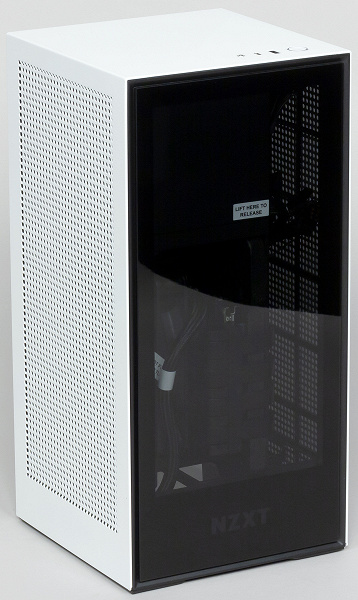
We continue to get acquainted with the representatives of the updated H series of NZXT cases. This time, our focus was on the NZXT H1 model, designed for Mini-ITX motherboards, but allowing the installation of a full-size video card.

The case exists in a single modification, in two colors – black and white. White (Matte White) also has black details, which looks very advantageous due to their contrast. Just such an option was provided to us for tests.

The steel elements of the case have a matte finish with a fine texture, which prevents the formation of noticeable dirt on the surface.

The case looks elegant and unusual due to its shape. It is a parallelepiped with an almost square base, and its height is about twice as large as the side of the base. Thus, it looks very harmonious and occupies a small area when installed vertically. If desired, the case can also be positioned horizontally, but it is important that the side vents are not blocked by anything.
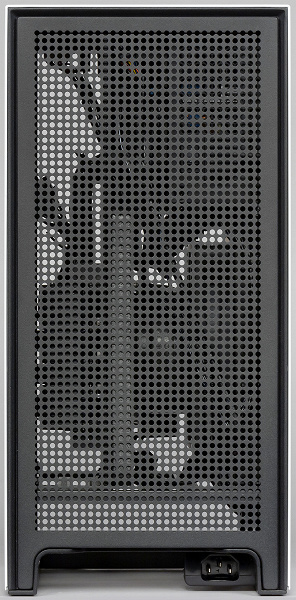
No lurid elements and heavy structures are also observed. This is achieved by using straight edges on all sides of the case, as well as minimizing the use of plastic parts in its external design. The outer part of the front panel is glass. In the black version, it is almost an office building. The only thing that confuses is a transparent wall, although little can be seen through it in principle. There is no backlight in the case, so those who want to highlight the system unit from the inside will have to take care of this issue on their own.
It should be noted that the case is supplied partially completed for system assembly, since its delivery set includes AIO type LSS with a size of 140 mm and a 650 W SFX-L format power supply unit ( NZXT NP-S650M ). Also, the case is equipped with a riser for connecting a video card. The packaging of the case is a regular cardboard box with monochrome printing. The set of fasteners is sorted into separate packages according to the types of elements, which saves time during assembly. There are also two adapters included in the package: one is for the front panel connectors, and the second is for the audio connectors.
Layout
The case is a tower-style solution with a vertically placed Mini-ITX board and a vertically placed power supply at the top.

The body is divided into two volumes. The largest bay has room for a full-size graphics card, behind the motherboard base. The other compartment houses the motherboard and power supply.

The motherboard is located vertically, but not in the standard way (with the connectors back), but with a 90-degree rotation – so that the connectors are directed downwards. It should be noted right away that the developers have provided enough space below the case (about 65 mm) so that cables and flash drives do not rest against the surface on which the case is installed.

The power supply is located in the same plane as the LSS heatsink, which is placed above the system board on a swivel bracket.

Near the system board under the power supply there is a small compartment for two 2.5-inch drives. There are no seats for drives with external access in the case.
The power supply can be in SFX-L or SFX formats, that is, if necessary, the standard PSU can be replaced. The power supply unit is located above the LSS radiator, if we consider the case, which is standardly installed vertically on the legs. Obviously, part of the air heated by the LSS will enter the power supply input, but this should not cause noticeable difficulties, since the exhaust from the LSS is mixed with the air in the room along the way.
In general, the layout is very original, and most of all it resembles gaming desktops, in which the motherboard, power supply and video card are located in the same plane, and a riser is used to connect the video card.
Cooling system
The only exhaust fan in the chassis is a 140mm LSS fan that draws air through the LSS heatsink and exhausts it out.

Airflow into the volume where the motherboard is installed is carried out from the back of the case. The power supply is almost taken out of the general heat exchange circuit, since it takes air directly through the side panel, and exhausts heated air from the rear panel of the case. The video card is installed in its own volume and has no effect on the compartment with the motherboard.

All filters are made of nylon mesh in a plastic frame, there are two of them.
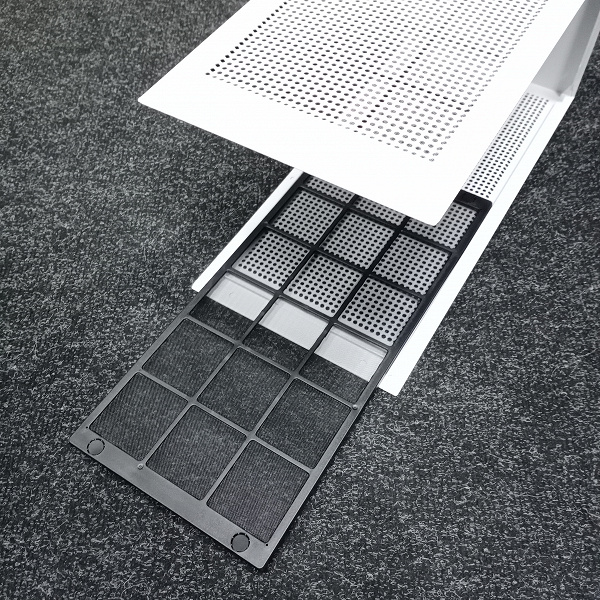
The filters are installed on the side walls of the housing, they are made removable, with fixation on a magnetic mount. Everything is done quite competently, protection against dust penetration in the case is at a fairly good level.
Design

The front panel is composite: a glass panel is placed on top of the steel base.
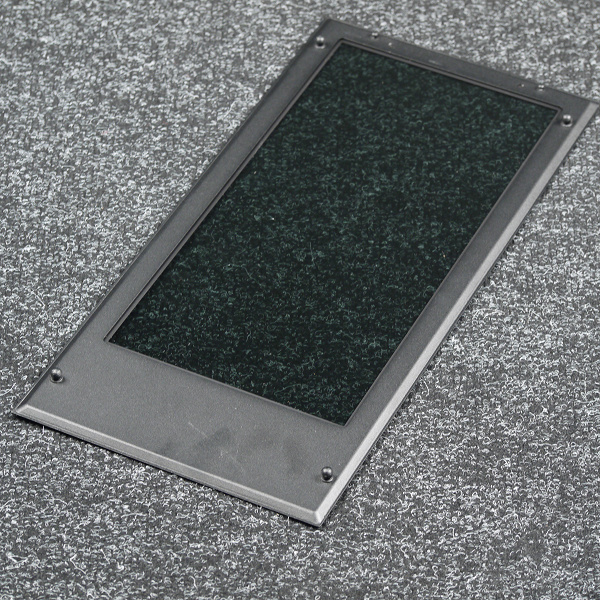
The rear panel is steel with ventilation holes throughout the area.

The left, right and upper walls are made in one piece, which is put on the body from above using a fastening system, which can be called a tongue and groove. The system itself is made of plastic, which makes the fixation tight and quite reliable.


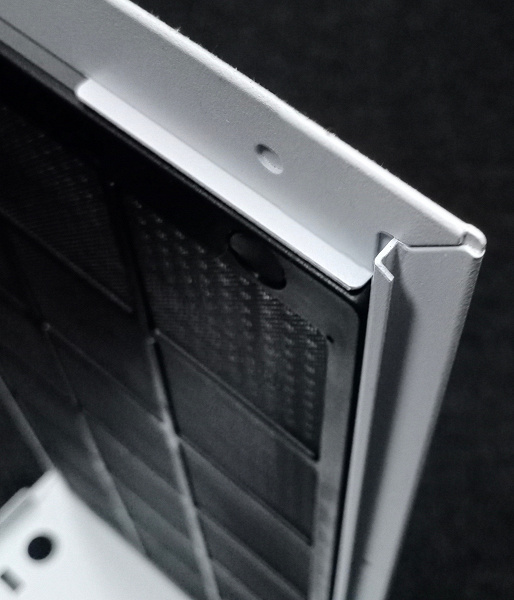
The power button and input / output ports are located on the top wall in front of the case. They include one USB 3.1 Gen 1 (USB 3.0), one USB 3.1 Gen 2 (USB 3.1) Type-C and a headset jack. Thus, the case allows you to connect wired headsets with both digital and analog interfaces from the front panel. But I would still like to see a little more USB connectors.

The case does not have a reset button, and the power button has a round shape, low speed and works with a loud click. The wraparound Power LED indicator is located under the round light guide near the power button, and the hard drive activity indicator is built into the same light guide as a small dot on the left. Both indicators glow with diffused white light.

The case is mounted on legs with rubber pads of medium hardness, which provide it with good stability and allow damping small vibrations from fans and hard drives, even when installed on a hard surface.
Drives

Access to the double basket is under the quick-release cover. Discs are installed using a screwless mounting system. A total of two 2.5-inch drives can be installed.
Assembly of the system unit
A special feature of the case is the completely screwless fastening of the outer panels.

The front wall of tempered glass is fixed with the help of spherical spacers, which are located along the perimeter of the frame. To dismantle, just pull it away from the body. The back wall has a similar design and is removed in the same way. The side and top walls are dismantled by lifting the single piece forming them.
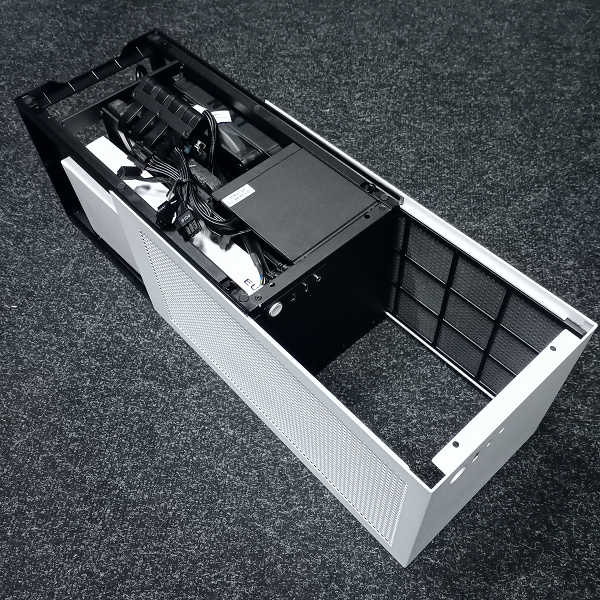
This part is fixed on the guides, along which it rises. In the seat, it is held by the installed front and rear panels.
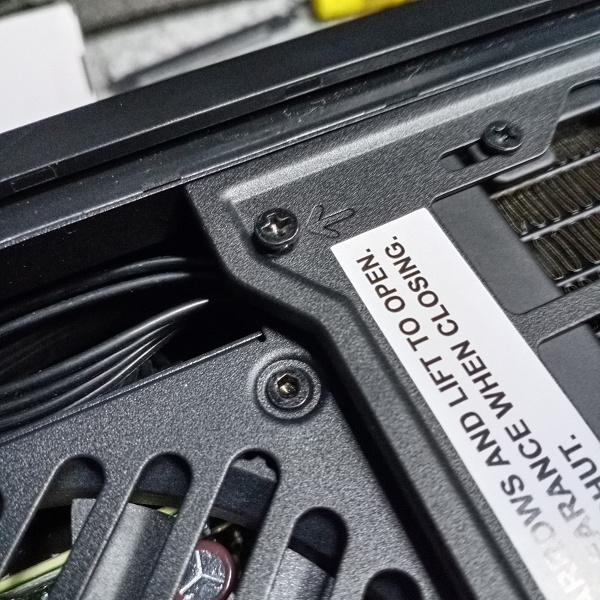
After removing the outer panels, you need to unscrew the two screws that fix the LSS radiator bracket and fold it back on the hinge. Everything is made as convenient as possible.
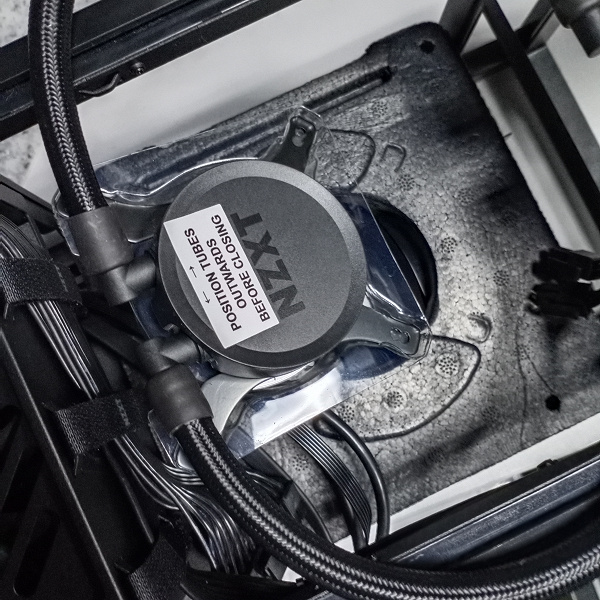
Next, you need to remove the LSS water block from the shipping insert and remove it from the case. After that, you can proceed to install the motherboard.

All racks for mounting the system board are pre-installed by the manufacturer. The wires from the power supply and from the front panel are routed, and the connectors are located exactly where they are needed during assembly.

Then you can proceed to install the LSS water block on the system board. In the case of the AM4 platform, the water block is installed on a regular cooler mount, and for the LGA115x platforms, there is a mounting plate in the kit, which must be installed first.

Next, you can install the required expansion boards, such as a video card, which can reach a length of about 300 millimeters. The manufacturer claims support for video cards occupying up to 2.5 slots in thickness. The video card is installed in a separate compartment using a complete riser.
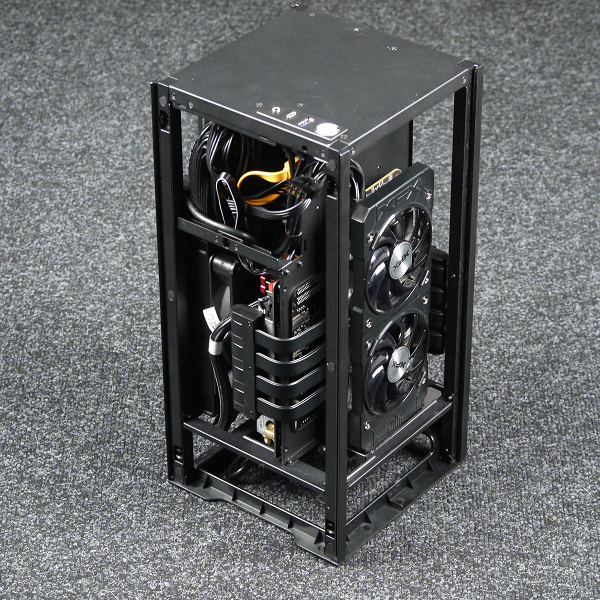

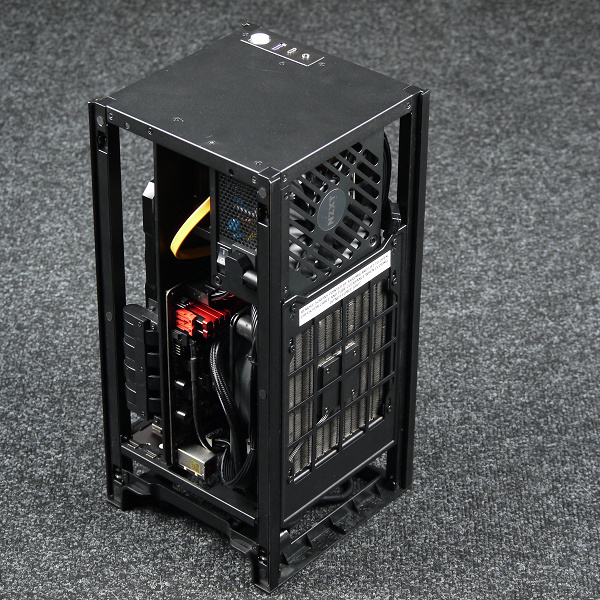
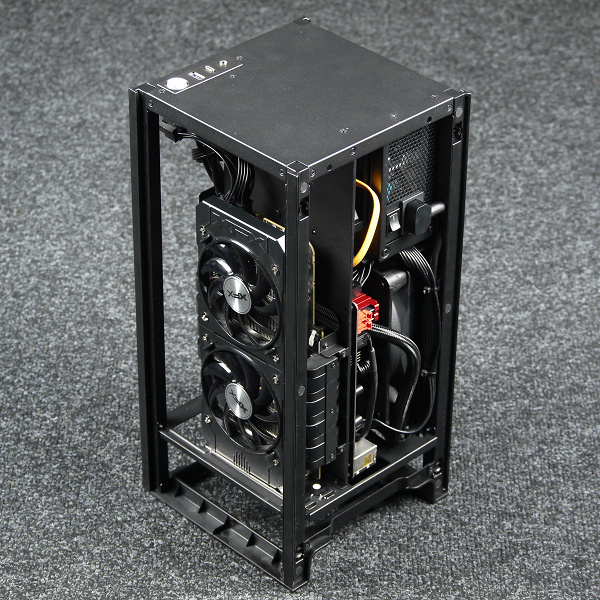
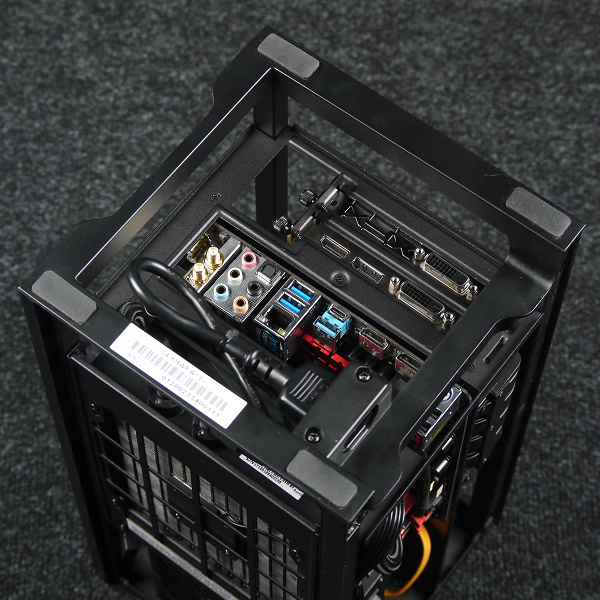
It’s nice to note that not only the USB and audio ports, but also the buttons and indicators from the front panel are connected to the motherboard with monolithic blocks (Intel FP): no heap of wires, no assembler suffering. True, a monolithic block may not be compatible with a certain board, and in this case there is an adapter that allows you to connect any board in the standard way.
Chassis Cooling Efficiency
Testing was conducted on the basis of the AM4 platform with an AMD Ryzen 2400G processor. To ensure maximum heat dissipation, powerMax software was used, which provides a high load on both the central processor and the graphics processor, which in this case are combined in one processor. All ten stages of testing were carried out sequentially within one day under identical external conditions with an ambient temperature of about 23 degrees. Each stage lasted at least 30 minutes, which ensured that the CPU temperature reached a steady state.
| PWM duty cycle, % | CPU temperature, °C | Coolant fan rotation speed, rpm |
|---|---|---|
| ten | 95.5 | 518 |
| 20 | 95.5 | 538 |
| thirty | 81.8 | 757 |
| 40 | 75 | 963 |
| fifty | 73 | 1154 |
| 60 | 69.5 | 1322 |
| 70 | 67.5 | 1480 |
| 80 | 66.5 | 1620 |
| 90 | 64.8 | 1746 |
| 100 | 63.5 | 1878 |
During testing, the PWM duty cycle varied from 10% to 100%. According to the results of testing, the case cooling system in the form of LSS successfully coped with the cooling of the processor with a rather high (for compact systems) consumption.
Acoustic ergonomics
The noise level of the cooling system was measured in parallel with the measurement of cooling efficiency. We changed the PWM duty cycle at a low load on the system (consumption from the power supply was about 103 W), the power supply fan did not rotate in this mode (it regularly turns on when the load power exceeds 200 W). Thus, in this case, the only source of noise was the LSS system (pump and fan).

In the assembled case, the noise level of the cooling system varies from 21.1 to 42.5 dBA when the microphone is located in the near field at a distance of 0.35 meters from the front panel of the case. With a PWM duty cycle of no more than 40%, the noise of the case cooling system is at a low level, and with a short circuit of up to 30%, the noise is minimally noticeable for a living space during the daytime (most of these levels will suit at night). High noise can be considered, starting from a short circuit of 90%.
Taking into account the fact that the case is designed to install a video card, the noise level was measured with an additional load on the power supply using resistors. The use of resistors is due to the absence of additional noise, unlike a real video card with such consumption. When you connect a block of resistors, the power consumption from the power supply increases to 350 W, and its fan starts to rotate, adding its noise to the overall sound pressure level.

With a short circuit = 10%, it is the power supply noise that is decisive, and the total system noise reaches 28 dBA, which can be considered a low level for a living space in the daytime, for working at a computer this noise level can be considered quite acceptable.
At short circuit = 50%, the noise is higher by 3 dBA (31.6 dBA) than at low load. A similar noise level can be considered average for a residential area during the daytime.
At short circuit = 100%, the noise is 2 dBA (44.7 dBA) higher than at low load. In both cases, the noise level can be considered high for a dwelling during the daytime.
It should be noted that such consumption will be possible only in resource-intensive tasks that load both the processor and the video card for a long time. In most typical tasks, this does not happen. Also, do not forget about the noise of a real video card, which was absent in our configuration.
In general, the acoustic ergonomics of the finished system can be assessed quite highly. This is not an excellent result, but given the minimum size of the system, it is at least very good.
Results
The developers obviously put a lot of work into the creation of the NZXT H1, making its internal structure convenient for the assembler, which is very difficult to implement in the case of compact cases. The cost of the case, of course, cannot be called low ($350 at the time of publication of the review), but taking into account the cost of the LSS, high-quality PSU ( NZXT NP-S650M ) and the riser, it is quite justified and competitive. We did not notice any obvious savings on materials. The design of this model, probably, can be called ascetic, but now it is more an advantage than a disadvantage. It would be interesting to see not only the standard set of black and white, but also some more original color or even several similar colors.
Summing up, we can say that the case turned out to be really successful and original, it deserves our editorial award for the current month:





